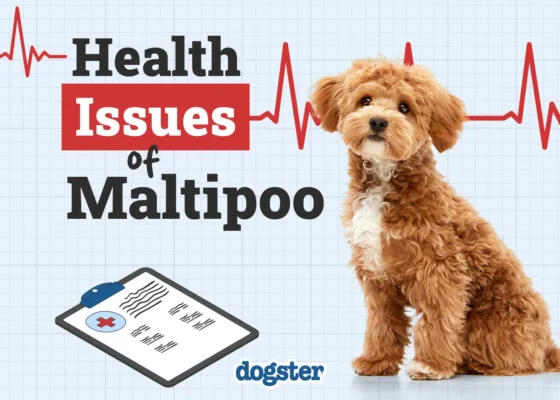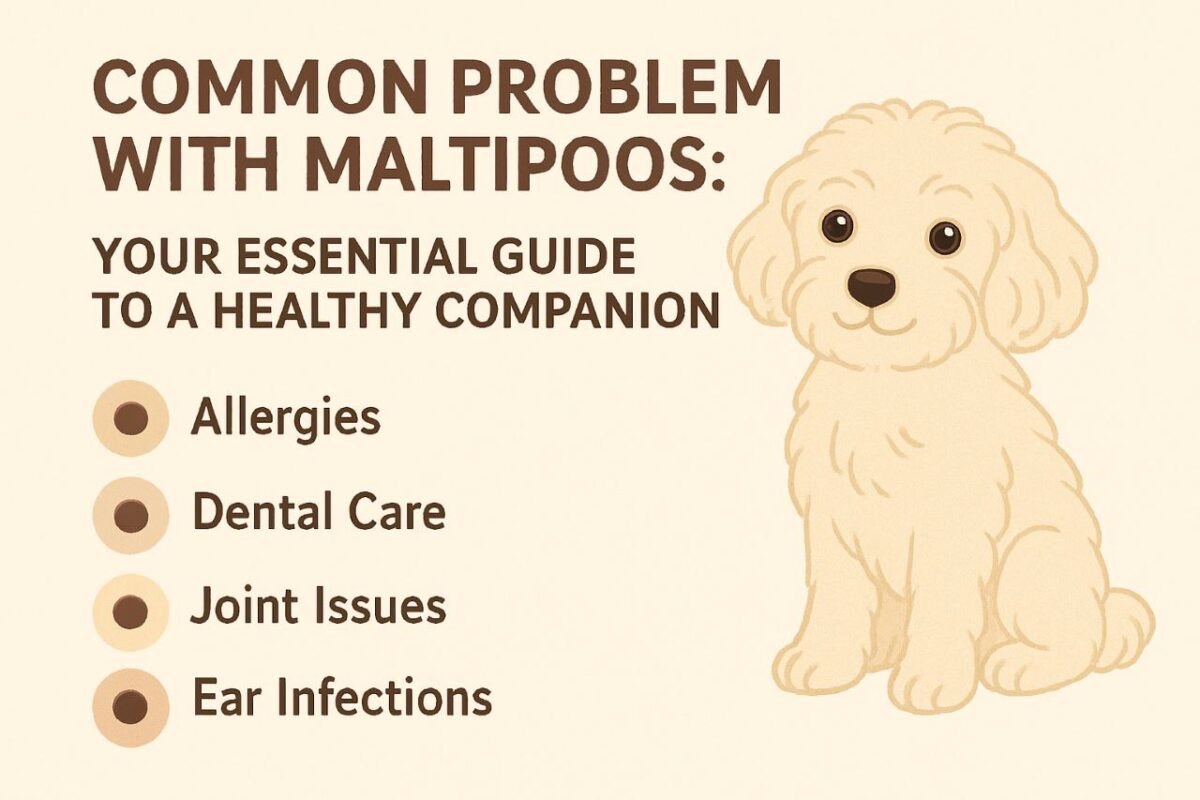Blog, MALTIPOO BLOG
Common Problem with Maltipoos: Your Essential Guide to Healthy Companionship
Introduction: Understanding the Common Problem with Maltipoos
Maltipoos, the enchanting hybrid of the affectionate Maltese and the intelligent Miniature or Toy Poodle, have won over dog lovers with their teddy-bear-like appearance, playful demeanor, and low-shedding coats. These small, charming companions are ideal for families, singles, and seniors across the globe, thriving in bustling city apartments or cozy suburban homes. However, prospective and current owners often ask, “What is a common problem with Maltipoos?”
This comprehensive guide delves into the most frequent challenges associated with the Maltipoo breed, including health issues, behavioral concerns, and care demands, offering practical solutions to ensure a healthy, happy pet. Whether you’re considering a Maltipoo puppy or already share your life with one, this article provides essential insights to navigate their unique needs, fostering a rewarding companionship.
Maltipoos are celebrated for their adaptability and affectionate nature, but like all breeds, they come with specific challenges that require proactive care. From dental problems to separation anxiety, understanding these issues empowers owners to provide the best environment for their furry friends. This guide explores the common problems with Maltipoos in detail, drawing on veterinary insights, behavioral expertise, and practical tips to help you address or prevent these concerns. With a global perspective, we aim to equip Maltipoo enthusiasts everywhere with the knowledge to ensure their pets thrive, whether in a high-rise in London, a beachside home in Sydney, or a countryside cottage in Tuscany.
The Maltipoo Breed: A Brief Overview
To contextualize the common problems with Maltipoos, it’s helpful to understand their origins and characteristics. The Maltipoo is a designer hybrid, developed in the late 20th century to combine the Maltese’s gentle, loving personality with the Poodle’s intelligence and hypoallergenic coat. The Maltese, with ancient roots as a companion to royalty, brings a warm, people-oriented demeanor, while the Miniature or Toy Poodle, known for its sharp mind and low-shedding fur, adds trainability and adaptability. This blend results in a small dog, typically weighing 5–20 pounds and standing 8–14 inches tall, with a soft, wavy-to-curly coat in colors like white, cream, apricot, or grey.
Maltipoos are prized for their “forever puppy” look and sociability, making them ideal for diverse households. However, their small size, hybrid genetics, and affectionate nature contribute to specific challenges that owners must address. By recognizing these issues early, you can tailor your care approach to keep your Maltipoo healthy and content, ensuring a long, joyful life together.

Common Health Problems with Maltipoos
Health issues are among the most frequent concerns when exploring the common problem with Maltipoos. As a hybrid, Maltipoos can inherit conditions from both parent breeds, requiring vigilant care and regular veterinary oversight.
One prevalent health issue is dental disease, a significant problem due to their small jaws and crowded teeth, which predispose them to plaque buildup, gingivitis, and periodontal disease. Without daily brushing or dental chews, tartar can accumulate, leading to painful infections or tooth loss, impacting their ability to eat comfortably. Veterinary cleanings, often costing $200–$500 depending on the region, may be needed annually, alongside at-home care with dog-safe toothpaste and brushes available at pet stores. Feeding kibble designed for dental health or providing rawhide-free chews can further support oral hygiene, reducing the risk of this common issue.
Another frequent concern is patellar luxation, where the kneecap slips out of place, causing discomfort or limping. This condition, inherited from both Maltese and Poodle lines, affects many small breeds and can range from mild, requiring monitoring, to severe, necessitating surgical correction costing $1,500–$3,000. Owners may notice their Maltipoo occasionally skipping or holding up a leg during walks, a sign to consult a veterinarian for X-rays or physical exams. Maintaining a healthy weight through a balanced diet and avoiding high-impact activities, like jumping off furniture, can help manage or prevent this issue, particularly in active Maltipoos.
Progressive Retinal Atrophy (PRA), an inherited eye condition, is another problem that can affect Maltipoos, leading to gradual vision loss and, in severe cases, blindness. This genetic disorder, more common in Poodles, requires screening by reputable breeders to reduce its prevalence. Owners may observe their Maltipoo bumping into objects or hesitating in low-light conditions, prompting a visit to a veterinary ophthalmologist. While there’s no cure, early diagnosis allows owners to adapt their home environment—such as keeping furniture consistent or using scent cues—to support a visually impaired Maltipoo, ensuring a high quality of life.
White Shaker Dog Syndrome, though less common, is a neurological condition primarily seen in small, white-coated breeds like Maltipoos. Characterized by tremors or shaking, especially during excitement or stress, this disorder is typically manageable with medications like corticosteroids, prescribed by veterinarians. Owners may first notice tremors in their Maltipoo during play or grooming, which can be alarming but is often treatable, allowing the dog to lead a normal life with proper care.
Skin allergies or sensitivities, exacerbated by environmental factors like pollen or dry climates, are also a recurring issue. Maltipoos may develop itchy skin, redness, or hot spots, particularly if their coat isn’t groomed regularly to remove allergens. Medicated shampoos, hypoallergenic diets, or antihistamines recommended by veterinarians can alleviate symptoms, while frequent brushing and bathing maintain coat health. These health challenges underscore the importance of regular veterinary checkups, a proactive approach to screening, and a commitment to at-home care to keep Maltipoos thriving.
Behavioral Challenges: A Common Problem with Maltipoos
Beyond health, behavioral issues are a significant common problem with Maltipoos, often tied to their affectionate and sensitive nature. One of the most prevalent is separation anxiety, a condition where Maltipoos become distressed when left alone, leading to behaviors like excessive barking, chewing, or accidents. Their “velcro dog” temperament, inherited from the Maltese’s desire for constant companionship, makes solitude challenging, particularly for owners with demanding schedules. A Maltipoo left alone in a Tokyo apartment or a rural Canadian home may bark incessantly, disturbing neighbors, or chew furniture out of stress, signaling a need for intervention.
Separation anxiety stems from their strong attachment to owners and can be exacerbated by inconsistent routines or insufficient socialization. Owners may notice their Maltipoo following them room to room or whining when they prepare to leave, early signs of distress. Addressing this requires gradual desensitization, starting with short absences of 5–10 minutes and slowly increasing to hours, paired with positive reinforcement like treats for calm behavior.
Crate training, introduced as a safe, cozy space with a favorite toy, can help Maltipoos feel secure during alone time, though crates should not be used for more than 4 hours for adults. Providing mental stimulation, such as puzzle toys or treat-dispensing devices, keeps them engaged, reducing anxiety-driven behaviors. For severe cases, consulting a dog behaviorist or trainer can provide tailored strategies, ensuring the Maltipoo adapts to brief periods of solitude.
Another behavioral challenge is excessive barking, often triggered by their alertness and sensitivity to environmental changes. Maltipoos may bark at strangers, noises, or passing animals, which can be problematic in urban settings like São Paulo or quiet neighborhoods in New Zealand. This behavior, rooted in their Poodle’s protective instincts, requires training to manage. Teaching commands like “quiet” with positive reinforcement, rewarding silence with treats or praise, helps curb barking. Early socialization to various sounds, people, and environments—such as busy parks or crowded streets—reduces reactivity, making Maltipoos more adaptable. Owners can also distract their Maltipoo with toys or activities during triggers, like a delivery person’s arrival, to redirect their focus.
House training difficulties can also arise, particularly in Maltipoo puppies, due to their small bladders and occasional stubbornness. Owners may find their Maltipoo having accidents indoors despite regular outdoor trips, a frustration in homes from Dubai to Dublin. Consistent schedules, frequent potty breaks (every 1–2 hours for puppies), and crate training to encourage bladder control are effective solutions. Rewarding successful outdoor eliminations with treats or praise reinforces good habits, while avoiding punishment prevents fear-based setbacks. Patience is key, as Maltipoos may take longer to master house training than larger breeds, but consistency yields results.

Grooming Challenges: A Maintenance Concern
Grooming is another common problem with Maltipoos, as their soft, wavy-to-curly coat, while low-shedding and hypoallergenic, demands significant upkeep. Without regular care, their coat can become matted, leading to discomfort, skin infections, or costly grooming sessions. Owners in humid climates like Singapore or dry regions like Cape Town may notice matting more quickly if brushing is neglected, as environmental factors exacerbate tangles. Daily brushing with a slicker brush or comb, taking 5–10 minutes, is essential to keep the coat smooth and free of debris, particularly around the ears, legs, and belly, where matting is common.
Bathing every 4–6 weeks with a gentle, dog-specific shampoo maintains coat health, but over-bathing can strip natural oils, causing dryness or irritation. Professional grooming every 4–8 weeks, costing $50–$100 globally, ensures a neat, teddy-bear look and prevents matting in hard-to-reach areas. Owners may struggle with grooming at home if their Maltipoo is fidgety or unaccustomed to handling, a challenge that requires gradual desensitization to brushes, clippers, or baths. Regular ear cleaning to prevent infections, nail trimming to avoid overgrowth, and dental brushing to complement health care are also part of the grooming routine, adding to the time commitment. For busy owners, outsourcing to professional groomers is a practical solution, though it increases costs.
Preventing and Managing Common Problems with Maltipoos
Addressing the common problems with Maltipoos requires a proactive, informed approach, blending preventive care with targeted solutions. For health issues, choosing a reputable breeder who conducts genetic screenings for PRA, patellar luxation, and other conditions is critical. These breeders, often found through registries like the North American Maltipoo Club, provide health clearances, reducing the likelihood of inherited issues. Regular veterinary checkups, at least annually, allow early detection of dental disease, joint problems, or eye conditions, while a balanced diet rich in protein and omega-3s, tailored for small breeds, supports overall health and coat condition.
Behavioral challenges like separation anxiety or barking benefit from early socialization, exposing Maltipoos to diverse people, pets, and environments from 8–12 weeks. Puppy classes or casual outings to parks or pet-friendly cafés build confidence, reducing reactivity. Training with positive reinforcement—using treats, praise, or play—establishes good habits, while consistent routines provide stability. For grooming, introducing Maltipoos to brushes and baths as puppies makes maintenance easier, and investing in quality tools, like detangling sprays or ergonomic combs, simplifies at-home care. Mental stimulation through puzzle toys or training games keeps Maltipoos engaged, preventing boredom-driven behaviors.
For owners facing persistent issues, professional help is invaluable. Veterinarians can address health concerns, while trainers or behaviorists offer tailored strategies for anxiety or barking. Online communities, such as Maltipoo owner forums or social media groups, provide global support, sharing tips from owners in cities like Melbourne or rural areas in Ireland. By combining these resources, owners can effectively manage the common problems with Maltipoos, ensuring a harmonious bond.

Living with a Maltipoo: Creating a Supportive Environment
Maltipoos thrive in environments that cater to their physical, emotional, and social needs, mitigating common problems. A safe, cozy space with a bed, water, and toys, free from hazards like toxic plants or small objects, supports their well-being. Regular exercise—30–45 minutes daily through walks or play—keeps them physically fit and mentally stimulated, reducing behavioral issues. A consistent routine for feeding, grooming, and training provides security, particularly for Maltipoos prone to anxiety. Social opportunities, like playdates or dog park visits, satisfy their outgoing nature, while quality time with owners reinforces their bond, minimizing separation distress.
FAQs About Common Problem with Maltipoos
1. What is the most common problem with Maltipoos?
Dental disease is a frequent issue due to their small jaws, leading to plaque buildup and infections. Daily brushing and veterinary cleanings prevent this problem, ensuring oral health.
2. Do Maltipoos often have separation anxiety?
Yes, separation anxiety is a common problem with Maltipoos due to their “velcro dog” nature. Gradual desensitization, crate training, and puzzle toys help them cope with alone time.
3. Are Maltipoos prone to joint issues?
Patellar luxation, where the kneecap slips, is common, causing limping or discomfort. Maintaining a healthy weight and avoiding high-impact activities reduce risks, with surgery for severe cases.
4. How can I prevent dental problems in Maltipoos?
Daily brushing with dog-safe toothpaste, dental chews, and annual veterinary cleanings prevent plaque buildup, a widespread issue in Maltipoos due to their small jaws.
5. Do Maltipoos have eye problems?
Progressive Retinal Atrophy (PRA) can cause vision loss, inherited from Poodles. Reputable breeders screen for PRA, and early veterinary exams help manage this condition.
6. Is grooming a common problem with Maltipoos?
Yes, their low-shedding coat requires daily brushing and professional grooming every 4–8 weeks to prevent matting, a challenge for busy owners but manageable with routine.
7. Why do Maltipoos bark excessively?
Their alertness and sensitivity lead to barking at noises or strangers. Training the “quiet” command and socialization to various environments reduce this behavior.
8. Are Maltipoos hard to house train?
Their small bladders make house training challenging, but consistent schedules, frequent potty breaks, and crate training ensure success with patience.
9. Can skin allergies be a problem with Maltipoos?
Yes, allergies to pollen or food can cause itchy skin or hot spots. Regular grooming, hypoallergenic diets, and medicated shampoos alleviate symptoms, guided by veterinarians.
10. How do I find a healthy Maltipoo to avoid common problems?
Choose reputable breeders with health clearances for PRA and patellar luxation, or adopt from shelters. Research and facility visits ensure a well-socialized, healthy puppy.
Conclusion: Navigating the Common Problem with Maltipoos
The common problem with Maltipoos—ranging from dental disease and patellar luxation to separation anxiety and grooming challenges—reflects their unique needs as a hybrid breed. Their small size, affectionate nature, and low-shedding coat make them delightful companions, but proactive care is essential to address these issues. By choosing a reputable breeder, maintaining regular veterinary and grooming routines, and investing in training and socialization, owners can mitigate these challenges, ensuring their Maltipoo thrives. This guide equips you with the knowledge to tackle the common problems with Maltipoos, fostering a joyful, healthy companionship that lasts 10–15 years, whether in a bustling city or a quiet countryside home.

